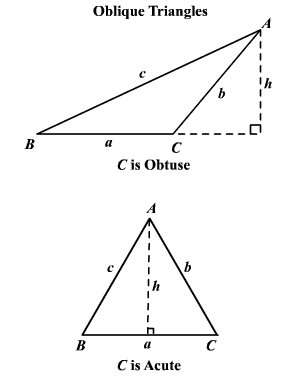Find the Solutions for a Triangle
Law of Sines
The Law of Sines is the relationship between the sides and angles of non-right (oblique) triangles . Simply, it states that the ratio of the length of a side of a triangle to the sine of the angle opposite that side is the same for all sides and angles in a given triangle.
In is an oblique triangle with sides and , then .

To use the Law of Sines you need to know either two angles and one side of the triangle (AAS or ASA) or two sides and an angle opposite one of them (SSA). Notice that for the first two cases we use the same parts that we used to prove congruence of triangles in geometry but in the last case we could not prove congruent triangles given these parts. This is because the remaining pieces could have been different sizes. This is called the ambiguous case and we will discuss it a little later.
Example 1: Given two angles and a non-included side (AAS).
Given with , and m. Find the remaining angle and sides.

The third angle of the triangle is
By the Law of Sines,
By the Properties of Proportions
and
Example 2: Given two angles and an included side (ASA).
Given , and cm. Find the remaining angle and sides.

The third angle of the triangle is:
By the Law of Sines,
By the Properties of Proportions
and
The Ambiguous Case
If two sides and an angle opposite one of them are given, three possibilities can occur.
(1) No such triangle exists.
(2) Two different triangles exist.
(3) Exactly one triangle exists.
Consider a triangle in which you are given and . (The altitude from vertex to side , by the definition of sines is equal to .)
(1) No such triangle exists if is acute and or is obtuse and .

(2) Two different triangles exist if is acute and .

(3) In every other case, exactly one triangle exists.

Example 1: No Solution Exists
Given and . Find the other angles and side.

Notice that . So it appears that there is no solution. Verify this using the Law of Sines.
This contrasts the fact that the . Therefore, no triangle exists.
Example 2: Two Solutions Exist
Given and . Find the other angles and side.
therefore, there are two triangles possible.

By the Law of Sines,
There are two angles between and whose sine is approximately 0.5833, are and .
Example 3: One Solution Exists
Given and . Find the other angles and side.

By the Law of Sines,
is acute.
By the Law of Sines,
If we are given two sides and an included angle of a triangle or if we are given sides of a triangle, we cannot use the Law of Sines because we cannot set up any proportions where enough information is known. In these two cases we must use the Law of Cosines .
Find the Solutions for a Triangle
Source: https://www.varsitytutors.com/hotmath/hotmath_help/topics/law-of-sines